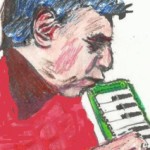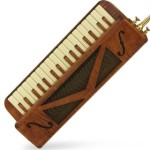The Amazing Melodica! – Tutorial (fragments )
Tagged: Tutorial full
- This topic has 81 replies, 10 voices, and was last updated 7 years, 1 month ago by
 jazzman1945.
jazzman1945.
-
AuthorPosts
-
September 5, 2016 at 6:23 pm #7616
 Melodica-MeParticipant
Melodica-MeParticipantGreat melodica version of Donna Lee. Thanks for sharing Jazzman
Melodica-MeSeptember 5, 2016 at 6:46 pm #7618 jazzman1945Participant
jazzman1945ParticipantIt is of course Sibelius; but the arrangement was intended for my ensemble Triom (Trio melodicas).
September 6, 2016 at 4:15 am #7620 Melodica-MeParticipant
Melodica-MeParticipantJazzman, Interesting, so we’re the melodicas midi samples or were they sampled from your actual melodica.
Melodica-MeSeptember 7, 2016 at 4:48 pm #7624 jazzman1945ParticipantSeptember 7, 2016 at 7:12 pm #7626
jazzman1945ParticipantSeptember 7, 2016 at 7:12 pm #7626 QuetscherParticipant
QuetscherParticipantFantastic playing!
September 8, 2016 at 10:26 am #7627 jazzman1945Participant
jazzman1945ParticipantThanks, Quetscher !
September 10, 2016 at 5:00 pm #7643 jazzman1945Participant
jazzman1945Participant( cont.)
b) Swallowing the third sound in a triplet:
“Tatats-Tatats-Tatats-Tatats”
Each of these exercises should be practiced first on one sound with pre-pressed key. This way breathing will be completely responsible for rhythm, swing and accuracy, while the right hand will only turn on the sound. Playing the keyboard requires, of course, complete coordination between breathing and the right hand fingers.
Exercises for achieving coordination between finger movements and breath are based on specifically chosen sound articulation with melodic line composed of these sounds.
In other words:
There is no such thing as ‘just a sound’ on Melodica – its articulation is always concrete as well as its pitch.September 11, 2016 at 3:59 pm #7644 jazzman1945Participant
jazzman1945ParticipantFor jazz articulation (and also for rock, funk etc.) we use various combinations of merge and separate performances of sounds of different lengths – quarters, eights, sixteenths – i.e. legato and not-legato, as well as accents and hits by the tongue, legato, non-legato and staccato by the right hand. These strokes combinations become pretty sophisticated, imitating the human speech. Melodica allows using this technique to some degree, but the tongue should not be used too forcibly as the sound might “shut up”. The degree to which it could be used changes not only from instrument to instrument but even from key to key on the same instrument. In any case, possibilities of articulation by tongue should be explored thoroughly on any concrete instrument.
September 14, 2016 at 8:39 am #7658 jazzman1945Participant
jazzman1945ParticipantSweet Georgia Brown : https://yadi.sk/d/uBOtdKxrv99xZ
September 14, 2016 at 9:08 am #7659 jazzman1945Participant
jazzman1945ParticipantPlaying the chords
Small Melodica’s keyboard allows playing doubles and chords of course. An adult’s hand can easily perform elevenths (octave + fourth) and even twelfths (octave + fifths); most of the pianists are unable to play these intervals on the piano with one hand.Chords can be easily constructed in these intervals as well.

If using the thumbs of both hands for supporting the instrument and also for playing the keyboard – then prolonged chords may be played by the right hand and the basses by the left. If using the flexible pipe, the instrument may be held in front, even on the knees, and the chords and basses can be played by both hands, as on the regular keyboard. But consider that playing chords uses more air; the more keys in the chord, the sooner you will run out of air.
But the strongest feature of playing chords on Melodica is the rhythmic articulation, while holding down the chord’s keys, for example, C6 chord – CEGA .September 14, 2016 at 9:16 am #7660 jazzman1945Participant
jazzman1945ParticipantSamba (even eights):
TA-ka-ta-KA-TA-ka-ta-KA.
Metronome: 120- 184 MM
http://i929.photobucket.com/albums/ad137/jazzman1945/Melodica/Samba_zps0gfcafkn.jpgSeptember 18, 2016 at 6:05 pm #7665 jazzman1945Participant
jazzman1945ParticipantTriplet feel
Playing 3 eights (triplet) for every beat:“KAtata-PAtata”, “KUtutu-PUtutu” etc.
Metronome from 60 MM to 92 MM
http://i929.photobucket.com/albums/ad137/jazzman1945/Melodica/Triplets_zps19iguucq.jpg
Swing (triplet swing feel):
Ta-Tat-ka-ta-Tat-ka-ta-Tat-ka
Metronome: 72-144 MMhttp://i929.photobucket.com/albums/ad137/jazzman1945/Melodica/Swing-_zps5kqjcmbz.jpg
September 18, 2016 at 6:17 pm #7666 jazzman1945Participant
jazzman1945ParticipantRiffs typical for 4 trumpets section in big band are easily performed:
||: N ku-tut Tat tu-Ku | tu-Ku Tat :||
http://i929.photobucket.com/albums/ad137/jazzman1945/Melodica/trumpets%20section_zps8tupwg75.jpgSeptember 20, 2016 at 9:42 am #7667 jazzman1945Participant
jazzman1945ParticipantRhythms performance through chords is preparing to participate in melodicas
ensemble. an ensemble that is most important to jazz /funk/pop/rock education.Funk
This rhythm can use not only exhalation but inhalation as well – slightly similar to the technique of Bobby Mc Ferrin or Michael Jackson. But inhalation does not create rhythmic sounds, only the rhythmic pauses – and this is exactly what is needed for funk.
Metronome: 50-84 MMhttp://i929.photobucket.com/albums/ad137/jazzman1945/Melodica/funk_zpsamoefbzv.jpg
Of course, rhythms previously are studied verbally.
September 24, 2016 at 7:28 am #7671 jazzman1945Participant
jazzman1945ParticipantStart improvising
There are plenty of various manuals and self-teaching books for studying jazz harmony, improvisation in jazz style, blues, country etc. Some of them are very basic and primitive, and some are on a high academic level. But all are based on the following requirements for improvisation:
1. Well developed musical ear
2. Mastering the instrument
3. Knowledge of the theory: chords, harmony, tones, phrases etc.Pianist has it all in the tips of his fingers: the sound, the technique, articulation, dynamics – all that we hear in his performance. And what a long time it takes to learn all that!
Pianist has it all in the tips of his fingers: the sound, the technique, articulation, dynamics – all that we hear in his performance. And what a long time it takes to learn all that!
Wind instruments have division of functions between fingers and breathing: fingers are responsible for the vents, like the keys on the piano; sound originates in the mouth. Again, many years of training are needed to learn how to produce full, beautiful sounds on the trumpet, clarinet, saxophone or bassoon! And it takes a lot of time to learn fingering on these instruments, while his own fingers the musician may see only in the mirror, and the wrong finger means wrong sound.
As for Melodica, we discover that even a child may start improvising on it right away, by pressing only one key or several at once and talking into the inlet slit. A word spoken into Melodica is being transformed directly into musical sounds. This is not fully a music yet, but the important elements are already here: form, phrases, breathing, rhythm, articulation, dynamics – and all this without the finger technique of the right hand, complete ignorance of the theory. Spoken language is becoming the rudimentary musical language… This kind of transforming speech into music is well demonstrated by the keyboard player from Hermeto Pascoal group – on the Festa Dos Deuses disc, the 5th track Pensamento Positivo.
Obviously, at this stage of sound making on Melodica other important elements are lacking: melodic intonation, melodic movement, as well as harmony. These are clearly functions of the right hand – here the technique is needed, as well as theory. Phrasing, breathing, rhythm, articulation, dynamics – all these demand years of learning and practice for any other instrument player, so that the instrument will sound similar to the human voice
Melodica, better that any other musical instrument, allows to achieve this effect directly, albeit on a limited scale. Any sound so performed, or even cluster, receive a very concrete meaning.
In author’s opinion, the importance of this feature for beginners is hard to overestimate.
Exercises are best practiced without the mouthpiece – otherwise it may sound like conversation with a smoking pipe in the mouth… -
AuthorPosts
- You must be logged in to reply to this topic.
